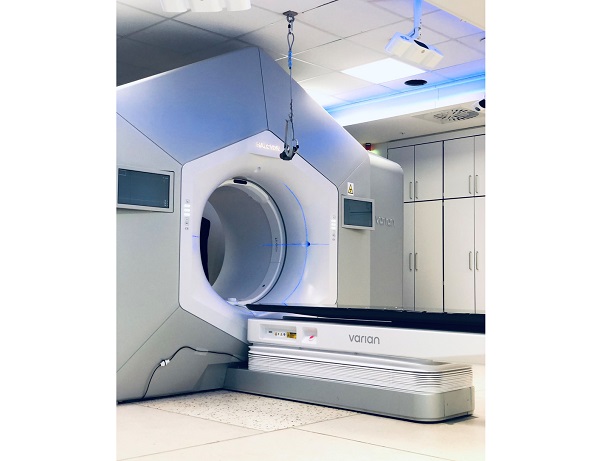 Credit: CFB
Credit: CFB
The Centre François Baclesse (CFB) in Esch-sur-Alzette has announced that it is now offering its breast cancer patients a technique to reduce the potential cardiac and pulmonary toxicities of breast radiotherapy: Deep Inspiration Breath Hold (DIBH).
The CFB noted in its press release on Wednesday 22 May 2024 that radiotherapy involves the use of ionizing radiation to destroy cancer cells, while preserving surrounding healthy tissues and organs as much as possible. When treating breast cancer (particularly the left breast), preserving the heart and cardiac sub-structures (such as the left coronary artery and left ventricle) is made more difficult by the proximity of the area to be treated.
The DIBH method, which has already been used on about 30 patients at the CFB, is based on blocked deep inspiration, which causes the ribcage to inflate, thus moving the heart and lung away from the treated breast. Radiotherapy is administered when the patient, after taking a deep breath, blocks her breathing for around 20 seconds several times during the session.
"This technique significantly reduces the average dose to the heart and cardiac sub-structures, decreasing long-term cardiac side effects (beyond 10-15-20 years) by an average of 7.5% per Gray (unit for measuring the dose absorbed during irradiation by ionizing radiation)," explained Dr Bérangère Frédérick, Radiation Oncologist at the CFB.
While this method may seem "very simple", noted the CFB, its implementation is "far more complex", requiring appropriate training of nursing staff and coaching of patients to ensure their compatibility with the method.
As Stéphane Ciota, Medical Technical Assistant in Radiology (ATM RX) at the CFB, explained: "Blocking your breathing for 20 seconds is not always easy under normal conditions; add to that the stress of the treatment, sometimes the patient's age, etc... that's why a lot of coaching is needed upstream to prepare patients as well as possible for this exercise."
Although DIBH treatment is based on a simple mechanical principle, it requires "extreme precision", which calls for the use of "state-of-the-art" equipment. The CFB said this was now possible at its facility thanks to the acquisition of three new AlignRT® surface positioning devices for surface-guided radiotherapy.
"This is a continuous three-dimensional acquisition of the patient's surface, based on the use of several optical cameras. The acquired surface is compared with an expected surface extracted from the initial simulation scan. ATM X-rays can continuously detect any malposition, anatomical deformity or patient misalignment. The system provides positioning assistance, possibly without tattooing, as well as patient follow-up during the session," explained Dr Bérangère Frédérick.
These devices reportedly make for greater precision and safety, and keep side effects to a minimum. "Until now, patient positioning was based solely on three tattoo points, which were sometimes difficult to place or even to find; by combining them with these new devices, it's as if we had thousands of fictitious tattoos at our disposal," asserted Stéphane Ciota.
The CFB recalled that radiotherapy is an effective treatment method, but not one that is without risk. After radiotherapy treatment, side effects, also known as "toxicity", are frequent and have an impact on the patient's quality of life. The practice of DIBH at the CFB is part of a global commitment to "better healing" the patient by minimising the risk of side effects.
"At the CFB, we have cutting-edge technologies and highly qualified teams at our disposal to give patients the best possible chance of recovery. Today, we want to go even further in supporting patients and enabling them to enjoy a better care experience, during and after radiotherapy treatment," assured Professor Vogin, General and Medical Director of the CFB.
According to the CFB, the practice of DIBH also illustrates a more participative approach to medicine, in which caregivers and patients form a real team. "This approach is based on voluntarism, so that the patient feels involved in her treatment," concluded Dr Bérangère Frédérick.
The CFB is a non-profit healthcare establishment that treats patients with curative or palliative radiotherapy indications. It is part of a multidisciplinary oncology context involving public and private hospitals in Luxembourg and the Greater Region. The centre noted that it aims to develop a network of excellence in oncology with other players in the region.








